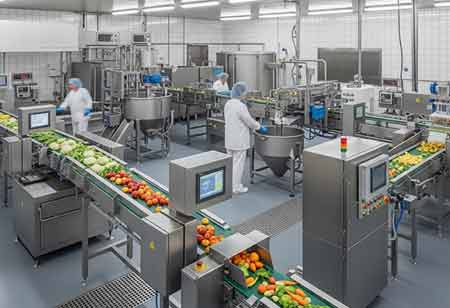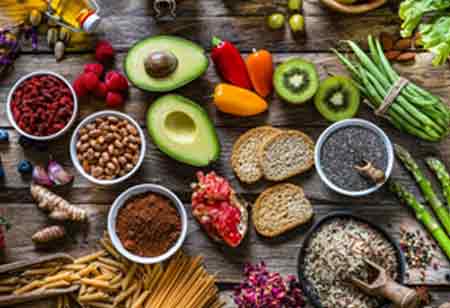THANK YOU FOR SUBSCRIBING
Be first to read the latest tech news, Industry Leader's Insights, and CIO interviews of medium and large enterprises exclusively from Food and Beverage Tech Review
The Strategic Shift in APAC's Food Manufacturing Landscape
The APAC food industry is evolving towards personalization and health, emphasizing transparency, customization, and innovative processing to meet discerning consumer demands for authenticity and nutrition.

By
Food and Beverages Tech Review | Tuesday, September 23, 2025
Stay ahead of the industry with exclusive feature stories on the top companies, expert insights and the latest news delivered straight to your inbox. Subscribe today.
The APAC food industry is shifting from mass production to a new era defined by personalization, health, and trust, driven by an increasingly discerning and informed consumer base. This shift is reshaping the entire food processing landscape, from sourcing raw materials to final product packaging. Modern processing trends are now defined by their ability to cater to individual preferences, deliver enhanced nutritional benefits, and provide an unprecedented level of transparency. The industry is responding with agility, adopting innovative technologies and flexible production models to meet these evolving demands.
Customization and Small-Batch Processing for Niche Markets
The modern consumer craves individuality and products that resonate with their specific needs and values. This has fueled the rise of customization and small-batch processing, moving away from high-volume, continuous production lines. Niche markets, such as those for vegan, gluten-free, keto, or paleo products, are no longer small segments but significant drivers of innovation. Processing facilities are increasingly designed for flexibility, allowing for rapid changeovers between product lines. This is achieved through modular equipment that can be reconfigured quickly, as well as efficient cleaning-in-place (CIP) systems that minimize downtime.
Small-batch processing enables manufacturers to produce limited quantities of highly specialized items, allowing for greater recipe innovation and the use of unique, often artisanal, ingredients. This approach fosters a sense of exclusivity and craftsmanship that resonates with consumers seeking authenticity. It also enables more precise control over the production process, resulting in a higher standard of quality and consistency for specialized goods. The ability to create a diverse range of products without the extensive costs and risks associated with large-scale production makes small-batch production a commercially viable and responsive model for meeting the diverse demands of today's food market.
Processing Solutions for Functional Foods and Nutraceuticals
Consumers are increasingly viewing food as a form of preventive medicine, leading to explosive growth in the functional foods and nutraceuticals market. These products are not just about basic sustenance; they are designed to deliver specific health benefits through the addition of bioactive compounds like probiotics, prebiotics, vitamins, minerals, and omega fatty acids. This trend necessitates sophisticated processing solutions that can handle these sensitive ingredients while preserving their efficacy and stability.
Advanced techniques such as microencapsulation and spray drying are now essential. Microencapsulation involves encasing delicate active ingredients in a protective shell, shielding them from degradation due to heat, light, or oxygen during processing and storage. This ensures that the beneficial compounds remain potent until consumption. Similarly, spray drying is used to convert liquid ingredients into a stable powder, making it easier to incorporate probiotics or other sensitive components into a wide range of products, from fortified cereals to powdered beverages. These technologies are crucial for creating products that deliver on their health promises, as they maintain the bioavailability and stability of the functional ingredients. The processing of these products requires meticulous control and precision to ensure the final product is both safe and effective.
Transparency and Storytelling through Digital Packaging in APAC
In APAC, consumers are particularly focused on food safety, origin, and authenticity. This has created a demand for complete transparency, which the industry is addressing by integrating digital technologies into packaging. Digital packaging and QR codes are transforming the simple label into a dynamic storytelling platform.
By simply scanning a QR code on a product, a consumer can access a wealth of information that goes far beyond what fits on a traditional label. This includes details about the product's journey from farm to table, its specific ingredients and their sources, as well as the processing methods used. This creates a powerful narrative that builds consumer trust and fosters a deeper connection with the brand. It enables manufacturers to demonstrate their commitment to quality, sustainability, and ethical sourcing in a verifiable and engaging manner. In a region where food fraud and safety concerns have been prevalent, this level of detailed, accessible information is not just a marketing tool—it's a fundamental requirement for consumer confidence.
The convergence of customization, functional nutrition, and digital transparency is defining the future of food processing. The industry is moving toward a more agile, technologically advanced, and consumer-centric model. Food processors are no longer just manufacturers; they are partners in a consumer's wellness journey, delivering products that are not only safe and nutritious but also deeply personal and transparent. The evolution of processing technology is therefore a direct reflection of a changing world where food is seen as a key component of a healthy, informed, and authentic lifestyle.
I agree We use cookies on this website to enhance your user experience. By clicking any link on this page you are giving your consent for us to set cookies. More info







